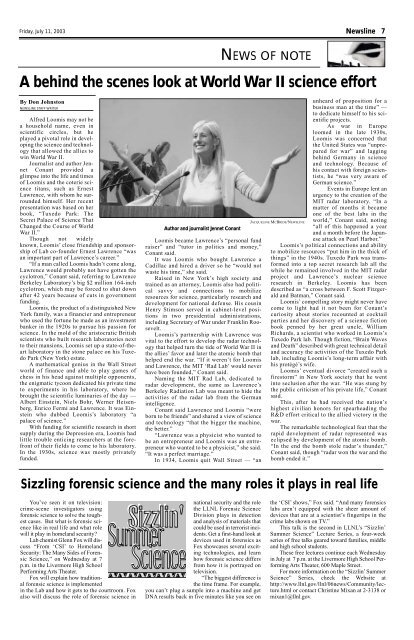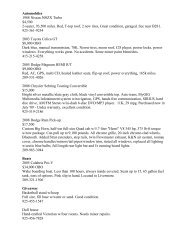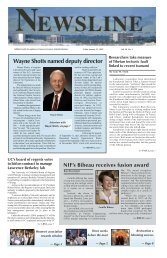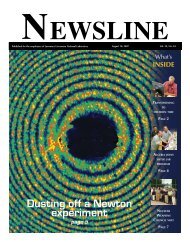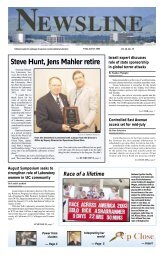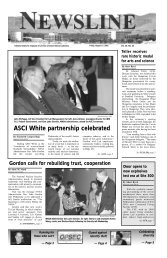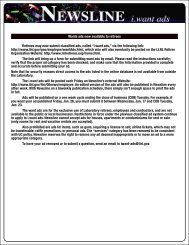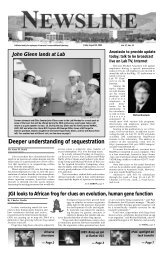Lab earns six R&D 100 Awards - NEWSLINE - Lawrence Livermore ...
Lab earns six R&D 100 Awards - NEWSLINE - Lawrence Livermore ...
Lab earns six R&D 100 Awards - NEWSLINE - Lawrence Livermore ...
Create successful ePaper yourself
Turn your PDF publications into a flip-book with our unique Google optimized e-Paper software.
Friday, July 11, 2003 Newsline 7<br />
A behind the scenes look at World War II science effort<br />
By Don Johnston<br />
<strong>NEWSLINE</strong> STAFF WRITER<br />
Alfred Loomis may not be<br />
a household name, even in<br />
scientific circles, but he<br />
played a pivotal role in developing<br />
the science and technology<br />
that allowed the allies to<br />
win World War II.<br />
Journalist and author Jennet<br />
Conant provided a<br />
glimpse into the life and times<br />
of Loomis and the coterie science<br />
titans, such as Ernest<br />
<strong>Lawrence</strong>, with whom he surrounded<br />
himself. Her recent<br />
presentation was based on her<br />
book, “Tuxedo Park: The<br />
Secret Palace of Science That<br />
Changed the Course of World<br />
War II.”<br />
Though not widely<br />
known, Loomis’ close friendship and sponsorship<br />
of <strong>Lab</strong> co-founder Ernest <strong>Lawrence</strong> “was<br />
an important part of <strong>Lawrence</strong>’s career.”<br />
“If a man called Loomis hadn’t come along,<br />
<strong>Lawrence</strong> would probably not have gotten the<br />
cyclotron,” Conant said, referring to <strong>Lawrence</strong><br />
Berkeley <strong>Lab</strong>oratory’s big $2 million 164-inch<br />
cyclotron, which may be forced to shut down<br />
after 42 years because of cuts in government<br />
funding.<br />
Loomis, the product of a distinguished New<br />
York family, was a financier and entrepreneur<br />
who used the fortune he made as an investment<br />
banker in the 1920s to pursue his passion for<br />
science. In the mold of the aristocratic British<br />
scientists who built research laboratories next<br />
to their mansions, Loomis set up a state-of-theart<br />
laboratory in the stone palace on his Tuxedo<br />
Park (New York) estate.<br />
A mathematical genius in the Wall Street<br />
world of finance and able to play games of<br />
chess in his head against multiple opponents,<br />
the enigmatic tycoon dedicated his private time<br />
to experiments in his laboratory, where he<br />
brought the scientific luminaries of the day —<br />
Albert Einstein, Niels Bohr, Werner Heisenberg,<br />
Enrico Fermi and <strong>Lawrence</strong>. It was Einstein<br />
who dubbed Loomis’s laboratory “a<br />
palace of science.”<br />
With funding for scientific research in short<br />
supply during the Depression era, Loomis had<br />
little trouble enticing researchers at the forefront<br />
of their fields to come to his laboratory.<br />
In the 1930s, science was mostly privately<br />
funded.<br />
Author and journalist Jennet Conant<br />
Loomis became <strong>Lawrence</strong>’s “personal fund<br />
raiser” and “tutor in politics and money,”<br />
Conant said.<br />
It was Loomis who bought <strong>Lawrence</strong> a<br />
Cadillac and hired a driver so he “would not<br />
waste his time,” she said.<br />
Raised in New York’s high society and<br />
trained as an attorney, Loomis also had political<br />
savvy and connections to mobilize<br />
resources for science, particularly research and<br />
development for national defense. His cousin<br />
Henry Stimson served in cabinet-level positions<br />
in two presidential administrations,<br />
including Secretary of War under Franklin Roosevelt.<br />
Loomis’s partnership with <strong>Lawrence</strong> was<br />
vital to the effort to develop the radar technology<br />
that helped turn the tide of World War II in<br />
the allies’ favor and later the atomic bomb that<br />
helped end the war. “If it weren’t for Loomis<br />
and <strong>Lawrence</strong>, the MIT ‘Rad <strong>Lab</strong>’ would never<br />
have been founded,” Conant said.<br />
Naming the MIT Rad <strong>Lab</strong>, dedicated to<br />
radar development, the same as <strong>Lawrence</strong>’s<br />
Berkeley Radiation <strong>Lab</strong> was meant to hide the<br />
activities of the radar lab from the German<br />
intelligence.<br />
Conant said <strong>Lawrence</strong> and Loomis “were<br />
born to be friends” and shared a view of science<br />
and technology “that the bigger the machine,<br />
the better.”<br />
“<strong>Lawrence</strong> was a physicist who wanted to<br />
be an entrepreneur and Loomis was an entrepreneur<br />
who wanted to be a physicist,” she said.<br />
“It was a perfect marriage.”<br />
In 1934, Loomis quit Wall Street — “an<br />
unheard of proposition for a<br />
business man at the time” —<br />
to dedicate himself to his scientific<br />
projects.<br />
As war in Europe<br />
loomed in the late 1930s,<br />
Loomis was concerned that<br />
the United States was “unprepared<br />
for war” and lagging<br />
behind Germany in science<br />
and technology. Because of<br />
his contact with foreign scientists,<br />
he “was very aware of<br />
German science.”<br />
Events in Europe lent an<br />
urgency to the creation of the<br />
MIT radar laboratory. “In a<br />
matter of months it became<br />
one of the best labs in the<br />
world,” Conant said, noting<br />
“all of this happened a year<br />
and a month before the Japanese<br />
attack on Pearl Harbor.”<br />
Loomis’s political connections and ability<br />
to mobilize resources “put him in the thick of<br />
things” in the 1940s. Tuxedo Park was transformed<br />
into a top secret research lab all the<br />
while he remained involved in the MIT radar<br />
project and <strong>Lawrence</strong>’s nuclear science<br />
research in Berkeley. Loomis has been<br />
described as “a cross between F. Scott Fitzgerald<br />
and Batman,” Conant said.<br />
Loomis’ compelling story might never have<br />
come to light had it not been for Conant’s<br />
curiosity about stories recounted at cocktail<br />
parties and her discovery of a science fiction<br />
book penned by her great uncle, William<br />
Richards, a scientist who worked in Loomis’s<br />
Tuxedo Park lab. Though fiction, “Brain Waves<br />
and Death” described with great technical detail<br />
and accuracy the activities of the Tuxedo Park<br />
lab, including Loomis’s long-term affair with<br />
his protégé’s wife.<br />
Loomis’ eventual divorce “created such a<br />
firestorm” in New York society that he went<br />
into seclusion after the war. “He was stung by<br />
the public criticism of his private life,” Conant<br />
said.<br />
This, after he had received the nation’s<br />
highest civilian honors for spearheading the<br />
R&D effort critical to the allied victory in the<br />
war.<br />
The remarkable technological feat that the<br />
rapid development of radar represented was<br />
eclipsed by development of the atomic bomb.<br />
“In the end the bomb stole radar’s thunder,”<br />
Conant said, though “radar won the war and the<br />
bomb ended it.”<br />
JACQUELINE MCBRIDE/<strong>NEWSLINE</strong><br />
Sizzling forensic science and the many roles it plays in real life<br />
You’ve seen it on television:<br />
crime-scene investigators using<br />
forensic science to solve the toughest<br />
cases. But what is forensic science<br />
like in real life and what role<br />
will it play in homeland security?<br />
<strong>Lab</strong> chemist Glenn Fox will discuss<br />
“From ‘CSI’ to Homeland<br />
Security: The Many Sides of Forensic<br />
Science,” on Wednesday at 7<br />
p.m. in the <strong>Livermore</strong> High School<br />
Performing Arts Theater.<br />
Fox will explain how traditional<br />
forensic science is implemented<br />
in the <strong>Lab</strong> and how it gets to the courtroom. Fox<br />
also will discuss the role of forensic science in<br />
national security and the role<br />
the LLNL Forensic Science<br />
Division plays in detection<br />
and analysis of materials that<br />
could be used in terrorist incidents.<br />
Get a first-hand look at<br />
devices used in forensics as<br />
Fox showcases several exciting<br />
technologies, and learn<br />
how forensic science differs<br />
from how it is portrayed on<br />
television.<br />
“The biggest difference is<br />
the time frame. For example,<br />
you can’t plug a sample into a machine and get<br />
DNA results back in five minutes like you see on<br />
NEWS OF NOTE<br />
the ‘CSI’ shows,” Fox said. “And many forensics<br />
labs aren’t equipped with the sheer amount of<br />
devices that are at a scientist’s fingertips in the<br />
crime labs shown on TV.”<br />
This talk is the second in LLNL’s “Sizzlin’<br />
Summer Science” Lecture Series, a four-week<br />
series of free talks geared toward families, middle<br />
and high school students.<br />
These free lectures continue each Wednesday<br />
in July at 7 p.m. at the <strong>Livermore</strong> High School Performing<br />
Arts Theater, 600 Maple Street.<br />
For more information on the “Sizzlin’ Summer<br />
Science” Series, check the Website at<br />
http://www.llnl.gov/llnl/06news/Community/lecture.html<br />
or contact Christine Mixan at 2-3138 or<br />
mixan1@llnl.gov.


